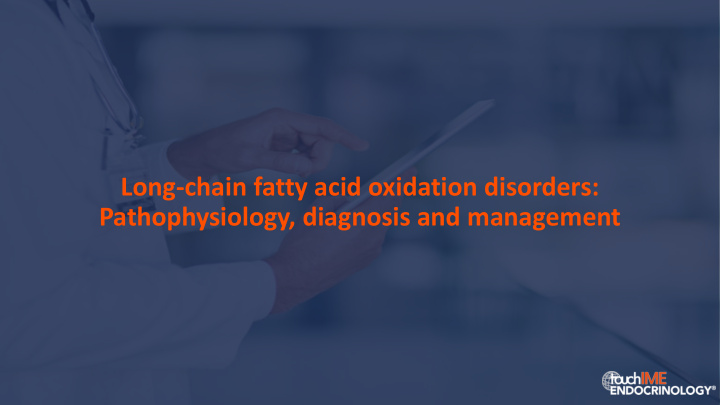



Long-chain fatty acid oxidation disorders: Pathophysiology, diagnosis and management
What are the signs and symptoms of LC-FAOD and how are they diagnosed? Prof. Dr. Ute Spiekerkötter Chair and Medical Director, Department of Pediatrics and Adolescent Medicine, University Children’s Hospital, Freiburg, Germany LC-FAOD, long-chain fatty acid oxidation disorders.
Disclaimer Unapproved products or unapproved uses of approved products may be discussed by the faculty; these situations may reflect the approval status in one or more jurisdictions. The presenting faculty have been advised by touchIME to ensure that they disclose any such references made to unlabelled or unapproved use. No endorsement by touchIME of any unapproved products or unapproved uses is either made or implied by mention of these products or uses in touchIME activities. touchIME accepts no responsibility for errors or omissions.
Presenting symptoms of LC-FAOD can vary with age and stressors 1–3 • Cardiomyopathy • Skeletal myopathy ‒ Left ventricular hypertrophy ‒ Myalgia ‒ Muscle weakness • Reye-like symptoms ‒ Exercise intolerance • Hypoglycaemia ‒ Elevated CK • Hypoketosis • Myoglobinuria • Hepatic dysfunction ‒ Recurrent rhabdomyolysis • Elevated transaminases , • Peripheral neuropathy/ ammonia and creatinine kinase retinopathy (for defined defects) • Metabolic acidosis • Fasting • Exercise Stressors • Concurrent illness LC-FAOD, long-chain fatty acid oxidation disorders. 1. Merritt JL II, et al. Ann Transl Med. 2018;6:473. 2. Knottnerus SJG, et al. Rev Endocr Metab Disord. 2018;19:93–106. 3. Spiekerkoetter U. J Inherit Metab Dis . 2010;33:527–32.
Heterogenous phenotypes in LC-FAOD 1–3 Asymptomatic Reye-like symptoms disease Peripheral Hypoglycaemia neuropathy (Reversible) Retinopathy cardiomyopathy Myopathy and (Reversible) hepatopathy rhabdomyolysis and hepatic steatosis LC-FAOD, long-chain fatty acid oxidation disorders. 1. Merritt JL II, et al. Ann Transl Med. 2018;6:473. 2. Knottnerus SJG, et al. Rev Endocr Metab Disord. 2018;19:93–106. 3. Spiekerkoetter U. J Inherit Metab Dis . 2010;33:527–32.
Diagnostic process for symptomatic patients with LC-FAOD 1–4 Routine laboratory studies Cardiac evaluation for LC-FAOD • Plasma acylcarnitine profile, total and free carnitine • Echocardiogram (urine acylglycine or organic acids) • Electrocardiogram • Mutation analysis, gene panel, or measurement of • (Chest radiography) specific enzyme activity • Transaminases, liver function, CPK, NT-proBNP, lactate, ammonia, full blood count CPK, creatinine phosphokinase; LC-FAOD, long-chain fatty acid oxidation disorders; NT-proBNP, N-terminal pro-B-type natriuretic peptide. 1. Spiekerkoetter U, et al. J Inherit Metab Dis . 2009;32:488–97. 2. Arnold GL, et al. Mol Genet Metab . 2009;96:85–90. 3. Hesse J, et al. J Inherit Metab Dis . 2018;41:1169–78. 4. Ruiz M, et al. Am J Physiol Heart Circ Physiol. 2017;313:H768–H81.
Newborn screening and diagnosis of FAOD 1-6 • Inclusion of different FAODs in standard newborn screening (national decisions) • Positive screening result does not confirm disease • Confirmed disease after positive screening is not necessarily indicative of symptomatic disease or related to disease severity Confirmation of diagnosis after Prediction of disease severity positive screen • No consistent genotype–phenotype correlation • Wide spectrum of mutations • Enzyme and mutational analysis • Correlation of residual enzyme activity and phenotype (also identification of heterozygotes) • Correlation with fatty acid oxidation flux in cultured skin fibroblasts FAOD, fatty acid oxidation disorders. 1. Andresen BS, et al. Am J Hum Genet . 1999;64:479–94. 2. Spiekerkoetter U, et al. J Pediatr. 2003;143:335–42. 3. Sturm M, et al. PLoS One . 2012;7:e45110; 4. Diekman EF, et al. Genet Med. 2015;17:989–94. 5. Hesse J, et al. J Inherit Metab Dis . 2018;41:1169–78. 6. Knottnerus SJG, et al. Biochim Biophys Acta Mol Basis Dis. 2020;1866:165725.
Optimal management of asymptomatic LC-FAOD 1–3 Risk assessment of Appropriate management Molecular and patients identified through • Are dietary management and enzymatic characterization newborn screening exercise restriction necessary? Many initially asymptomatic patients have later onset of symptoms (often myopathic), stressors may induce various symptoms, which can be life-threatening Patient may remain asymptomatic • Lifelong observation is warranted in all patients with FAOD FAOD, fatty acid oxidation disorders; LC-FAOD, long-chain fatty acid oxidation disorders. 1. Spiekerkoetter U, et al. J Pediatr . 2003;143:335–42. 2. Kang E, et al. BMC Pediatrics. 2018;18:103. 3. Merritt JL II, et al. Ann Transl Med . 2018;6:473.
Recommend
More recommend